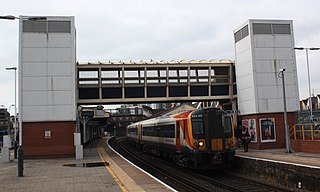
The London, Brighton and South Coast Railway was a railway company in the United Kingdom from 1846 to 1922. Its territory formed a rough triangle, with London at its apex, practically the whole coastline of Sussex as its base, and a large part of Surrey. It was bounded on its western side by the London and South Western Railway (L&SWR), which provided an alternative route to Portsmouth. On its eastern side the LB&SCR was bounded by the South Eastern Railway (SER)—later one component of the South Eastern and Chatham Railway (SE&CR)—which provided an alternative route to Bexhill, St Leonards-on-Sea, and Hastings. The LB&SCR had the most direct routes from London to the south coast seaside resorts of Brighton, Eastbourne, Worthing, Littlehampton and Bognor Regis, and to the ports of Newhaven and Shoreham-by-Sea. It served the inland towns/cities of Chichester, Horsham, East Grinstead and Lewes, and jointly served Croydon, Tunbridge Wells, Dorking and Guildford. At the London end was a complicated suburban and outer-suburban network of lines emanating from London Bridge and Victoria, and shared interests in two cross-London lines.

Brighton railway station is the southern terminus of the Brighton main line in England, and the principal station serving the city of Brighton, East Sussex. It is 50 miles 49 chains (81.45 km) from London Bridge via Redhill.

The West Coastway line is a railway line in England following closely the south coast of Sussex and Hampshire, between the cities of Brighton and Southampton. It has short southward branches to Littlehampton and Bognor Regis. Some trains using part of the route operate as direct continuations of passenger services to/from London, particularly those to the branch stations mentioned.

Fratton railway station is a railway station in the city of Portsmouth, on Portsea Island in the United Kingdom. It was opened in the Fratton area of Portsmouth on 1 July 1885 as an interchange station between the London, Brighton and South Coast Railway and the short-lived Southsea Railway branchline.

Eastleigh railway station serves the town of Eastleigh in the county of Hampshire in England. It is located on the South Western Main Line and is the junction station for two other routes, the Eastleigh-Fareham Line and the Eastleigh-Romsey Line. It is 73 miles 35 chains (118.2 km) from London Waterloo. South of the station are Eastleigh Railway Works and Eastleigh Depot.

This article describes the shipping services of the London and South Western Railway and the vessels employed.
PS Victoria was a passenger vessel built for the London and South Western Railway and London, Brighton and South Coast Railway in 1881.
PS Duchess of Edinburgh was a passenger vessel built for the London and South Western Railway and London, Brighton and South Coast Railway in 1884.
PS Duchess of Connaught was a passenger vessel built for the London and South Western Railway and London, Brighton and South Coast Railway in 1884.
PS Princess Margaret was a passenger vessel built for the London and South Western Railway and London, Brighton and South Coast Railway in 1893.
PS Duchess of Richmond was a passenger vessel built for the London and South Western Railway and London, Brighton and South Coast Railway in 1910.
PS Duchess of Kent was a passenger vessel built for the London and South Western Railway and London, Brighton and South Coast Railway in 1897.
PS Duchess of Fife was a passenger vessel built for the London and South Western Railway and London, Brighton and South Coast Railway in 1899.
SS Laura was a passenger vessel built for the London and South Western Railway in 1885.
SS Frederica was a passenger vessel built for the London and South Western Railway in 1890. She later served in the Ottoman Navy as the minelayer Nilufer and was sunk during World War I.

SS Lydia was a passenger vessel built for the London and South Western Railway in 1890.

PS Shanklin was a passenger vessel built for the Southern Railway in 1924 for use on the Portsmouth Harbour to Ryde Pier route.
PS Whippingham was a passenger vessel built for the Southern Railway in 1930.

PS Sandown was a passenger vessel built for the Southern Railway in 1934.
PS Solent was a passenger vessel built for the London and South Western Railway in 1902.








